UK Audit Committee: Roles, Responsibilities & Good Governance Dev.
VerifiedAdded on 2023/06/18
|37
|13815
|493
Thesis and Dissertation
AI Summary
This dissertation critically analyzes the development of the roles and responsibilities of the UK Audit Committee in promoting effective and good governance, particularly within Foundation Trusts (FTs). It highlights the significance of the audit committee in ensuring accurate and reliable financial reporting to stakeholders. The study investigates the committee's composition, objectives, and evolution, referencing the UK Corporate Governance Code and relevant theoretical frameworks like Institutional Theory. The research employs exploratory and explanatory methods, including case studies and document reviews, to assess the audit committee's effectiveness in the public sector. Findings suggest that while the audit committee's functions are generally effective, ongoing development and addressing existing challenges are crucial. The study recommends training programs for audit committee members, emphasizing honesty, fairness, and professionalism among auditors, and fostering stronger relationships between auditors and management to enhance the reliability and quality of accounting reports.
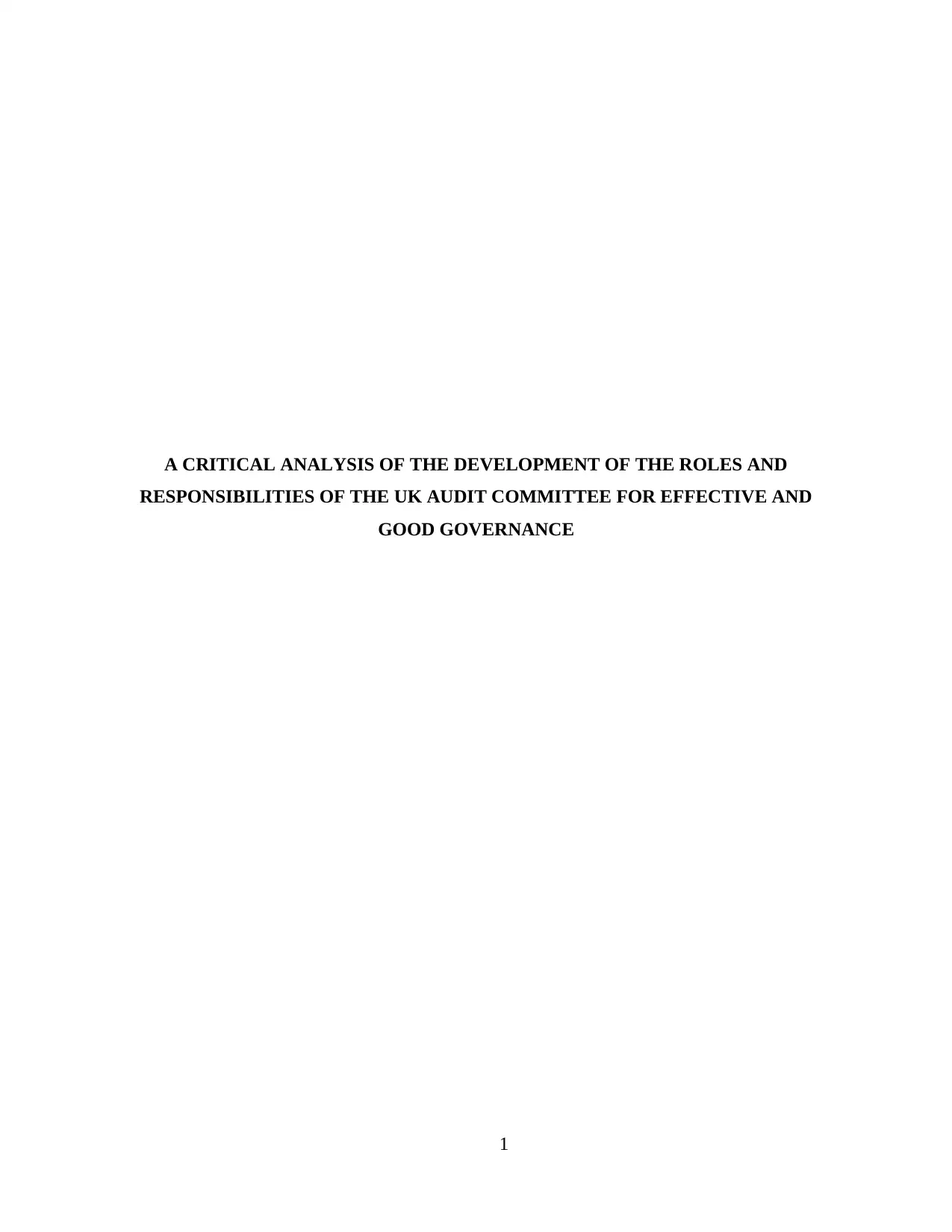
A CRITICAL ANALYSIS OF THE DEVELOPMENT OF THE ROLES AND
RESPONSIBILITIES OF THE UK AUDIT COMMITTEE FOR EFFECTIVE AND
GOOD GOVERNANCE
1
RESPONSIBILITIES OF THE UK AUDIT COMMITTEE FOR EFFECTIVE AND
GOOD GOVERNANCE
1
Paraphrase This Document
Need a fresh take? Get an instant paraphrase of this document with our AI Paraphraser
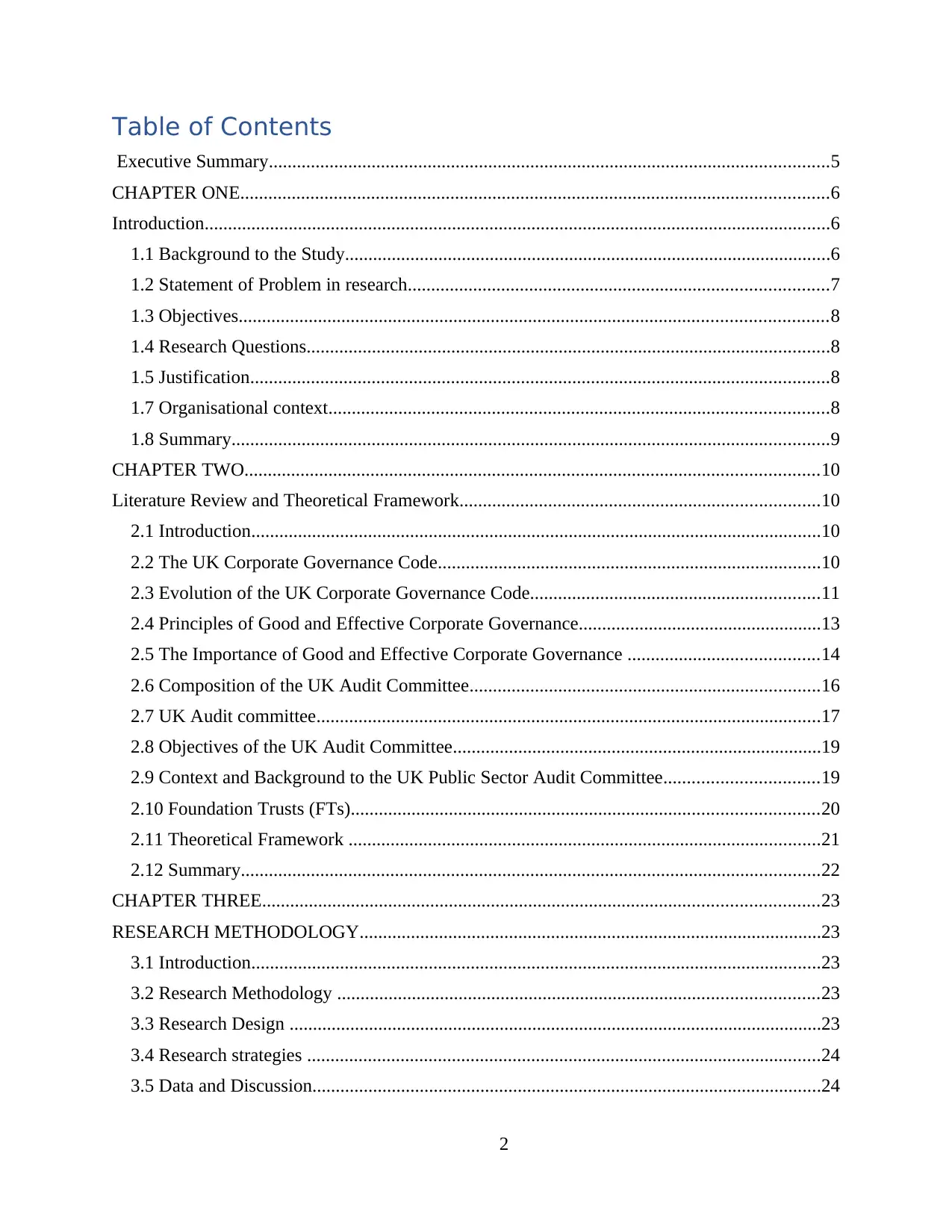
Table of Contents
Executive Summary........................................................................................................................5
CHAPTER ONE..............................................................................................................................6
Introduction......................................................................................................................................6
1.1 Background to the Study........................................................................................................6
1.2 Statement of Problem in research..........................................................................................7
1.3 Objectives..............................................................................................................................8
1.4 Research Questions................................................................................................................8
1.5 Justification............................................................................................................................8
1.7 Organisational context...........................................................................................................8
1.8 Summary................................................................................................................................9
CHAPTER TWO...........................................................................................................................10
Literature Review and Theoretical Framework.............................................................................10
2.1 Introduction..........................................................................................................................10
2.2 The UK Corporate Governance Code..................................................................................10
2.3 Evolution of the UK Corporate Governance Code..............................................................11
2.4 Principles of Good and Effective Corporate Governance....................................................13
2.5 The Importance of Good and Effective Corporate Governance .........................................14
2.6 Composition of the UK Audit Committee...........................................................................16
2.7 UK Audit committee............................................................................................................17
2.8 Objectives of the UK Audit Committee...............................................................................19
2.9 Context and Background to the UK Public Sector Audit Committee.................................19
2.10 Foundation Trusts (FTs)....................................................................................................20
2.11 Theoretical Framework .....................................................................................................21
2.12 Summary............................................................................................................................22
CHAPTER THREE.......................................................................................................................23
RESEARCH METHODOLOGY...................................................................................................23
3.1 Introduction..........................................................................................................................23
3.2 Research Methodology .......................................................................................................23
3.3 Research Design ..................................................................................................................23
3.4 Research strategies ..............................................................................................................24
3.5 Data and Discussion.............................................................................................................24
2
Executive Summary........................................................................................................................5
CHAPTER ONE..............................................................................................................................6
Introduction......................................................................................................................................6
1.1 Background to the Study........................................................................................................6
1.2 Statement of Problem in research..........................................................................................7
1.3 Objectives..............................................................................................................................8
1.4 Research Questions................................................................................................................8
1.5 Justification............................................................................................................................8
1.7 Organisational context...........................................................................................................8
1.8 Summary................................................................................................................................9
CHAPTER TWO...........................................................................................................................10
Literature Review and Theoretical Framework.............................................................................10
2.1 Introduction..........................................................................................................................10
2.2 The UK Corporate Governance Code..................................................................................10
2.3 Evolution of the UK Corporate Governance Code..............................................................11
2.4 Principles of Good and Effective Corporate Governance....................................................13
2.5 The Importance of Good and Effective Corporate Governance .........................................14
2.6 Composition of the UK Audit Committee...........................................................................16
2.7 UK Audit committee............................................................................................................17
2.8 Objectives of the UK Audit Committee...............................................................................19
2.9 Context and Background to the UK Public Sector Audit Committee.................................19
2.10 Foundation Trusts (FTs)....................................................................................................20
2.11 Theoretical Framework .....................................................................................................21
2.12 Summary............................................................................................................................22
CHAPTER THREE.......................................................................................................................23
RESEARCH METHODOLOGY...................................................................................................23
3.1 Introduction..........................................................................................................................23
3.2 Research Methodology .......................................................................................................23
3.3 Research Design ..................................................................................................................23
3.4 Research strategies ..............................................................................................................24
3.5 Data and Discussion.............................................................................................................24
2
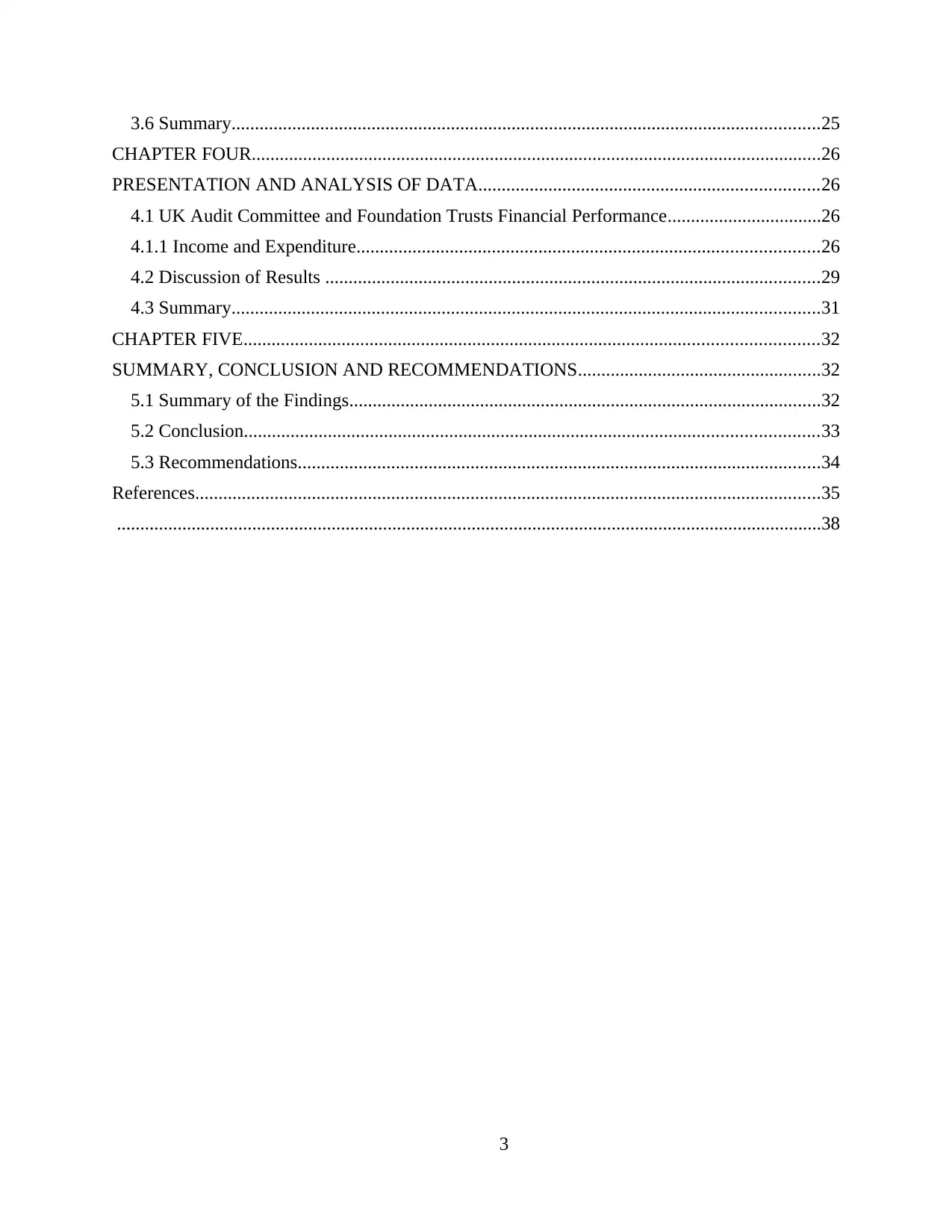
3.6 Summary..............................................................................................................................25
CHAPTER FOUR..........................................................................................................................26
PRESENTATION AND ANALYSIS OF DATA.........................................................................26
4.1 UK Audit Committee and Foundation Trusts Financial Performance.................................26
4.1.1 Income and Expenditure...................................................................................................26
4.2 Discussion of Results ..........................................................................................................29
4.3 Summary..............................................................................................................................31
CHAPTER FIVE...........................................................................................................................32
SUMMARY, CONCLUSION AND RECOMMENDATIONS....................................................32
5.1 Summary of the Findings.....................................................................................................32
5.2 Conclusion...........................................................................................................................33
5.3 Recommendations................................................................................................................34
References......................................................................................................................................35
.......................................................................................................................................................38
3
CHAPTER FOUR..........................................................................................................................26
PRESENTATION AND ANALYSIS OF DATA.........................................................................26
4.1 UK Audit Committee and Foundation Trusts Financial Performance.................................26
4.1.1 Income and Expenditure...................................................................................................26
4.2 Discussion of Results ..........................................................................................................29
4.3 Summary..............................................................................................................................31
CHAPTER FIVE...........................................................................................................................32
SUMMARY, CONCLUSION AND RECOMMENDATIONS....................................................32
5.1 Summary of the Findings.....................................................................................................32
5.2 Conclusion...........................................................................................................................33
5.3 Recommendations................................................................................................................34
References......................................................................................................................................35
.......................................................................................................................................................38
3
⊘ This is a preview!⊘
Do you want full access?
Subscribe today to unlock all pages.

Trusted by 1+ million students worldwide
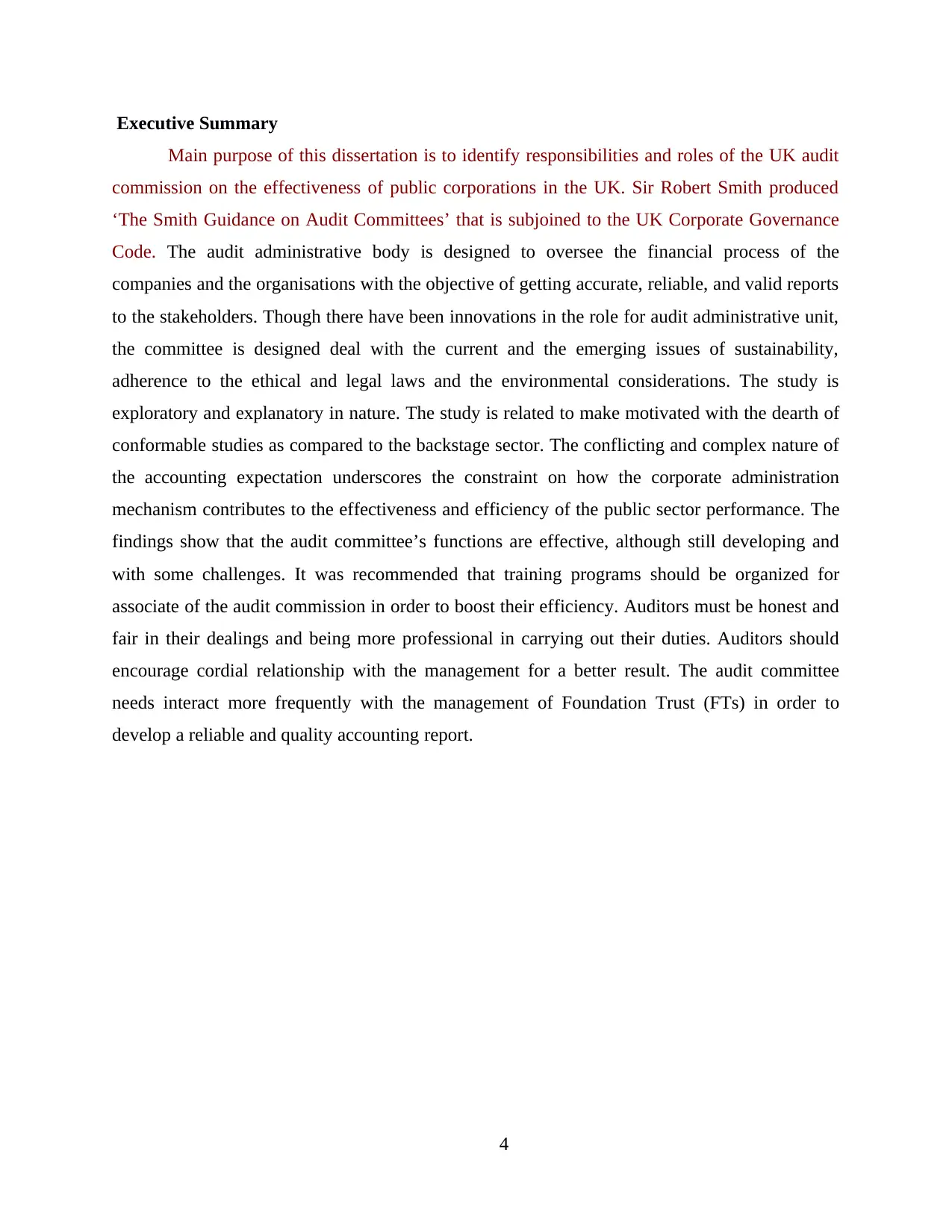
Executive Summary
Main purpose of this dissertation is to identify responsibilities and roles of the UK audit
commission on the effectiveness of public corporations in the UK. Sir Robert Smith produced
‘The Smith Guidance on Audit Committees’ that is subjoined to the UK Corporate Governance
Code. The audit administrative body is designed to oversee the financial process of the
companies and the organisations with the objective of getting accurate, reliable, and valid reports
to the stakeholders. Though there have been innovations in the role for audit administrative unit,
the committee is designed deal with the current and the emerging issues of sustainability,
adherence to the ethical and legal laws and the environmental considerations. The study is
exploratory and explanatory in nature. The study is related to make motivated with the dearth of
conformable studies as compared to the backstage sector. The conflicting and complex nature of
the accounting expectation underscores the constraint on how the corporate administration
mechanism contributes to the effectiveness and efficiency of the public sector performance. The
findings show that the audit committee’s functions are effective, although still developing and
with some challenges. It was recommended that training programs should be organized for
associate of the audit commission in order to boost their efficiency. Auditors must be honest and
fair in their dealings and being more professional in carrying out their duties. Auditors should
encourage cordial relationship with the management for a better result. The audit committee
needs interact more frequently with the management of Foundation Trust (FTs) in order to
develop a reliable and quality accounting report.
4
Main purpose of this dissertation is to identify responsibilities and roles of the UK audit
commission on the effectiveness of public corporations in the UK. Sir Robert Smith produced
‘The Smith Guidance on Audit Committees’ that is subjoined to the UK Corporate Governance
Code. The audit administrative body is designed to oversee the financial process of the
companies and the organisations with the objective of getting accurate, reliable, and valid reports
to the stakeholders. Though there have been innovations in the role for audit administrative unit,
the committee is designed deal with the current and the emerging issues of sustainability,
adherence to the ethical and legal laws and the environmental considerations. The study is
exploratory and explanatory in nature. The study is related to make motivated with the dearth of
conformable studies as compared to the backstage sector. The conflicting and complex nature of
the accounting expectation underscores the constraint on how the corporate administration
mechanism contributes to the effectiveness and efficiency of the public sector performance. The
findings show that the audit committee’s functions are effective, although still developing and
with some challenges. It was recommended that training programs should be organized for
associate of the audit commission in order to boost their efficiency. Auditors must be honest and
fair in their dealings and being more professional in carrying out their duties. Auditors should
encourage cordial relationship with the management for a better result. The audit committee
needs interact more frequently with the management of Foundation Trust (FTs) in order to
develop a reliable and quality accounting report.
4
Paraphrase This Document
Need a fresh take? Get an instant paraphrase of this document with our AI Paraphraser
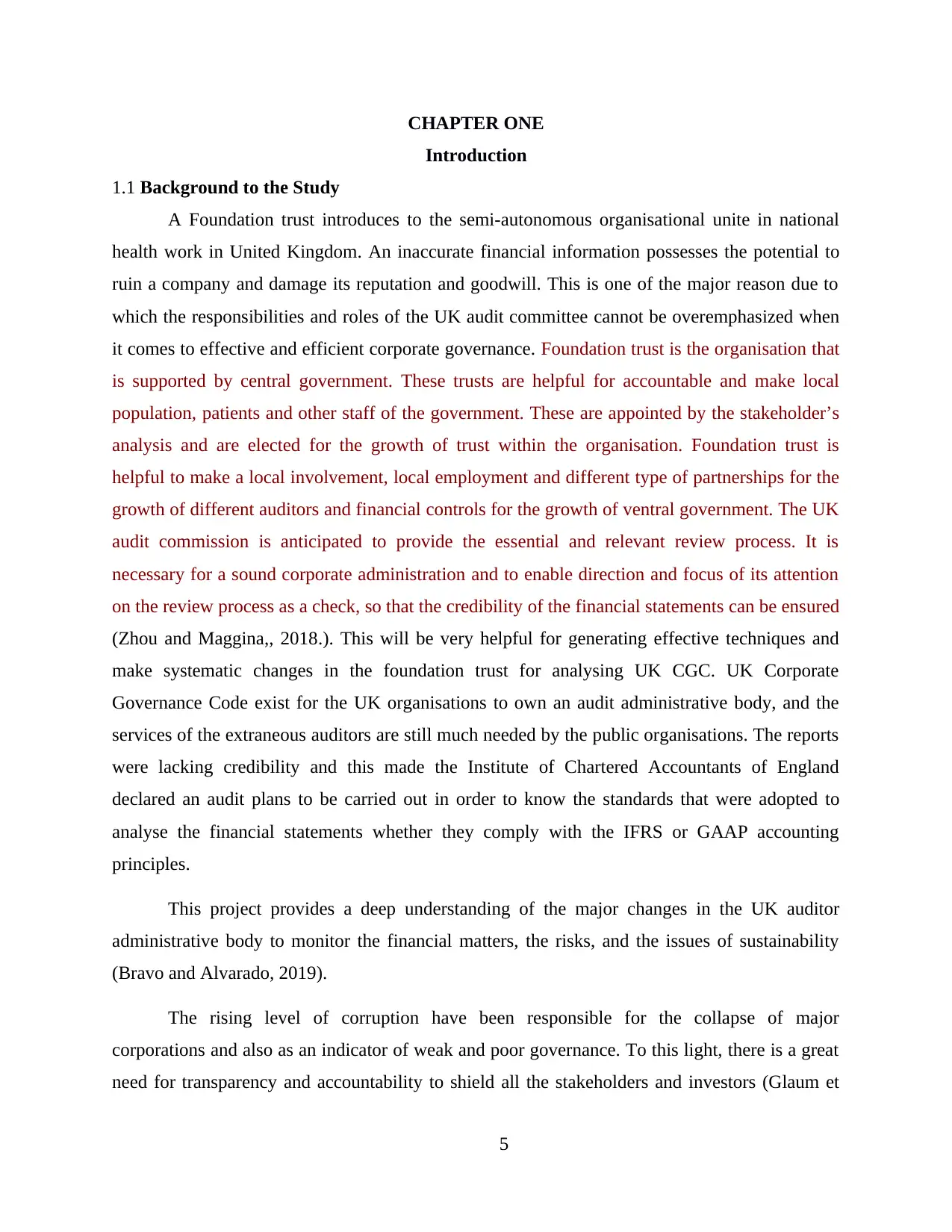
CHAPTER ONE
Introduction
1.1 Background to the Study
A Foundation trust introduces to the semi-autonomous organisational unite in national
health work in United Kingdom. An inaccurate financial information possesses the potential to
ruin a company and damage its reputation and goodwill. This is one of the major reason due to
which the responsibilities and roles of the UK audit committee cannot be overemphasized when
it comes to effective and efficient corporate governance. Foundation trust is the organisation that
is supported by central government. These trusts are helpful for accountable and make local
population, patients and other staff of the government. These are appointed by the stakeholder’s
analysis and are elected for the growth of trust within the organisation. Foundation trust is
helpful to make a local involvement, local employment and different type of partnerships for the
growth of different auditors and financial controls for the growth of ventral government. The UK
audit commission is anticipated to provide the essential and relevant review process. It is
necessary for a sound corporate administration and to enable direction and focus of its attention
on the review process as a check, so that the credibility of the financial statements can be ensured
(Zhou and Maggina,, 2018.). This will be very helpful for generating effective techniques and
make systematic changes in the foundation trust for analysing UK CGC. UK Corporate
Governance Code exist for the UK organisations to own an audit administrative body, and the
services of the extraneous auditors are still much needed by the public organisations. The reports
were lacking credibility and this made the Institute of Chartered Accountants of England
declared an audit plans to be carried out in order to know the standards that were adopted to
analyse the financial statements whether they comply with the IFRS or GAAP accounting
principles.
This project provides a deep understanding of the major changes in the UK auditor
administrative body to monitor the financial matters, the risks, and the issues of sustainability
(Bravo and Alvarado, 2019).
The rising level of corruption have been responsible for the collapse of major
corporations and also as an indicator of weak and poor governance. To this light, there is a great
need for transparency and accountability to shield all the stakeholders and investors (Glaum et
5
Introduction
1.1 Background to the Study
A Foundation trust introduces to the semi-autonomous organisational unite in national
health work in United Kingdom. An inaccurate financial information possesses the potential to
ruin a company and damage its reputation and goodwill. This is one of the major reason due to
which the responsibilities and roles of the UK audit committee cannot be overemphasized when
it comes to effective and efficient corporate governance. Foundation trust is the organisation that
is supported by central government. These trusts are helpful for accountable and make local
population, patients and other staff of the government. These are appointed by the stakeholder’s
analysis and are elected for the growth of trust within the organisation. Foundation trust is
helpful to make a local involvement, local employment and different type of partnerships for the
growth of different auditors and financial controls for the growth of ventral government. The UK
audit commission is anticipated to provide the essential and relevant review process. It is
necessary for a sound corporate administration and to enable direction and focus of its attention
on the review process as a check, so that the credibility of the financial statements can be ensured
(Zhou and Maggina,, 2018.). This will be very helpful for generating effective techniques and
make systematic changes in the foundation trust for analysing UK CGC. UK Corporate
Governance Code exist for the UK organisations to own an audit administrative body, and the
services of the extraneous auditors are still much needed by the public organisations. The reports
were lacking credibility and this made the Institute of Chartered Accountants of England
declared an audit plans to be carried out in order to know the standards that were adopted to
analyse the financial statements whether they comply with the IFRS or GAAP accounting
principles.
This project provides a deep understanding of the major changes in the UK auditor
administrative body to monitor the financial matters, the risks, and the issues of sustainability
(Bravo and Alvarado, 2019).
The rising level of corruption have been responsible for the collapse of major
corporations and also as an indicator of weak and poor governance. To this light, there is a great
need for transparency and accountability to shield all the stakeholders and investors (Glaum et
5
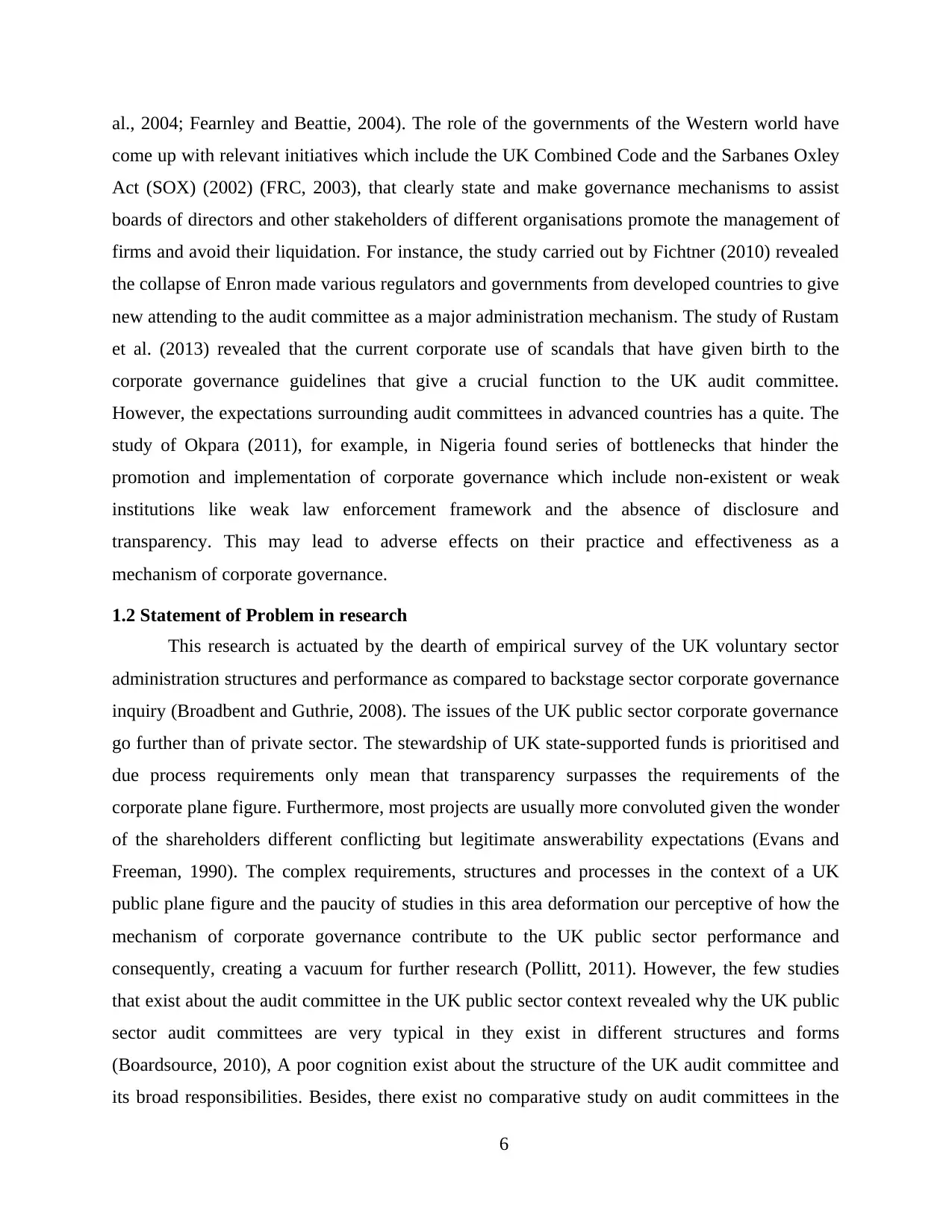
al., 2004; Fearnley and Beattie, 2004). The role of the governments of the Western world have
come up with relevant initiatives which include the UK Combined Code and the Sarbanes Oxley
Act (SOX) (2002) (FRC, 2003), that clearly state and make governance mechanisms to assist
boards of directors and other stakeholders of different organisations promote the management of
firms and avoid their liquidation. For instance, the study carried out by Fichtner (2010) revealed
the collapse of Enron made various regulators and governments from developed countries to give
new attending to the audit committee as a major administration mechanism. The study of Rustam
et al. (2013) revealed that the current corporate use of scandals that have given birth to the
corporate governance guidelines that give a crucial function to the UK audit committee.
However, the expectations surrounding audit committees in advanced countries has a quite. The
study of Okpara (2011), for example, in Nigeria found series of bottlenecks that hinder the
promotion and implementation of corporate governance which include non-existent or weak
institutions like weak law enforcement framework and the absence of disclosure and
transparency. This may lead to adverse effects on their practice and effectiveness as a
mechanism of corporate governance.
1.2 Statement of Problem in research
This research is actuated by the dearth of empirical survey of the UK voluntary sector
administration structures and performance as compared to backstage sector corporate governance
inquiry (Broadbent and Guthrie, 2008). The issues of the UK public sector corporate governance
go further than of private sector. The stewardship of UK state-supported funds is prioritised and
due process requirements only mean that transparency surpasses the requirements of the
corporate plane figure. Furthermore, most projects are usually more convoluted given the wonder
of the shareholders different conflicting but legitimate answerability expectations (Evans and
Freeman, 1990). The complex requirements, structures and processes in the context of a UK
public plane figure and the paucity of studies in this area deformation our perceptive of how the
mechanism of corporate governance contribute to the UK public sector performance and
consequently, creating a vacuum for further research (Pollitt, 2011). However, the few studies
that exist about the audit committee in the UK public sector context revealed why the UK public
sector audit committees are very typical in they exist in different structures and forms
(Boardsource, 2010), A poor cognition exist about the structure of the UK audit committee and
its broad responsibilities. Besides, there exist no comparative study on audit committees in the
6
come up with relevant initiatives which include the UK Combined Code and the Sarbanes Oxley
Act (SOX) (2002) (FRC, 2003), that clearly state and make governance mechanisms to assist
boards of directors and other stakeholders of different organisations promote the management of
firms and avoid their liquidation. For instance, the study carried out by Fichtner (2010) revealed
the collapse of Enron made various regulators and governments from developed countries to give
new attending to the audit committee as a major administration mechanism. The study of Rustam
et al. (2013) revealed that the current corporate use of scandals that have given birth to the
corporate governance guidelines that give a crucial function to the UK audit committee.
However, the expectations surrounding audit committees in advanced countries has a quite. The
study of Okpara (2011), for example, in Nigeria found series of bottlenecks that hinder the
promotion and implementation of corporate governance which include non-existent or weak
institutions like weak law enforcement framework and the absence of disclosure and
transparency. This may lead to adverse effects on their practice and effectiveness as a
mechanism of corporate governance.
1.2 Statement of Problem in research
This research is actuated by the dearth of empirical survey of the UK voluntary sector
administration structures and performance as compared to backstage sector corporate governance
inquiry (Broadbent and Guthrie, 2008). The issues of the UK public sector corporate governance
go further than of private sector. The stewardship of UK state-supported funds is prioritised and
due process requirements only mean that transparency surpasses the requirements of the
corporate plane figure. Furthermore, most projects are usually more convoluted given the wonder
of the shareholders different conflicting but legitimate answerability expectations (Evans and
Freeman, 1990). The complex requirements, structures and processes in the context of a UK
public plane figure and the paucity of studies in this area deformation our perceptive of how the
mechanism of corporate governance contribute to the UK public sector performance and
consequently, creating a vacuum for further research (Pollitt, 2011). However, the few studies
that exist about the audit committee in the UK public sector context revealed why the UK public
sector audit committees are very typical in they exist in different structures and forms
(Boardsource, 2010), A poor cognition exist about the structure of the UK audit committee and
its broad responsibilities. Besides, there exist no comparative study on audit committees in the
6
⊘ This is a preview!⊘
Do you want full access?
Subscribe today to unlock all pages.

Trusted by 1+ million students worldwide
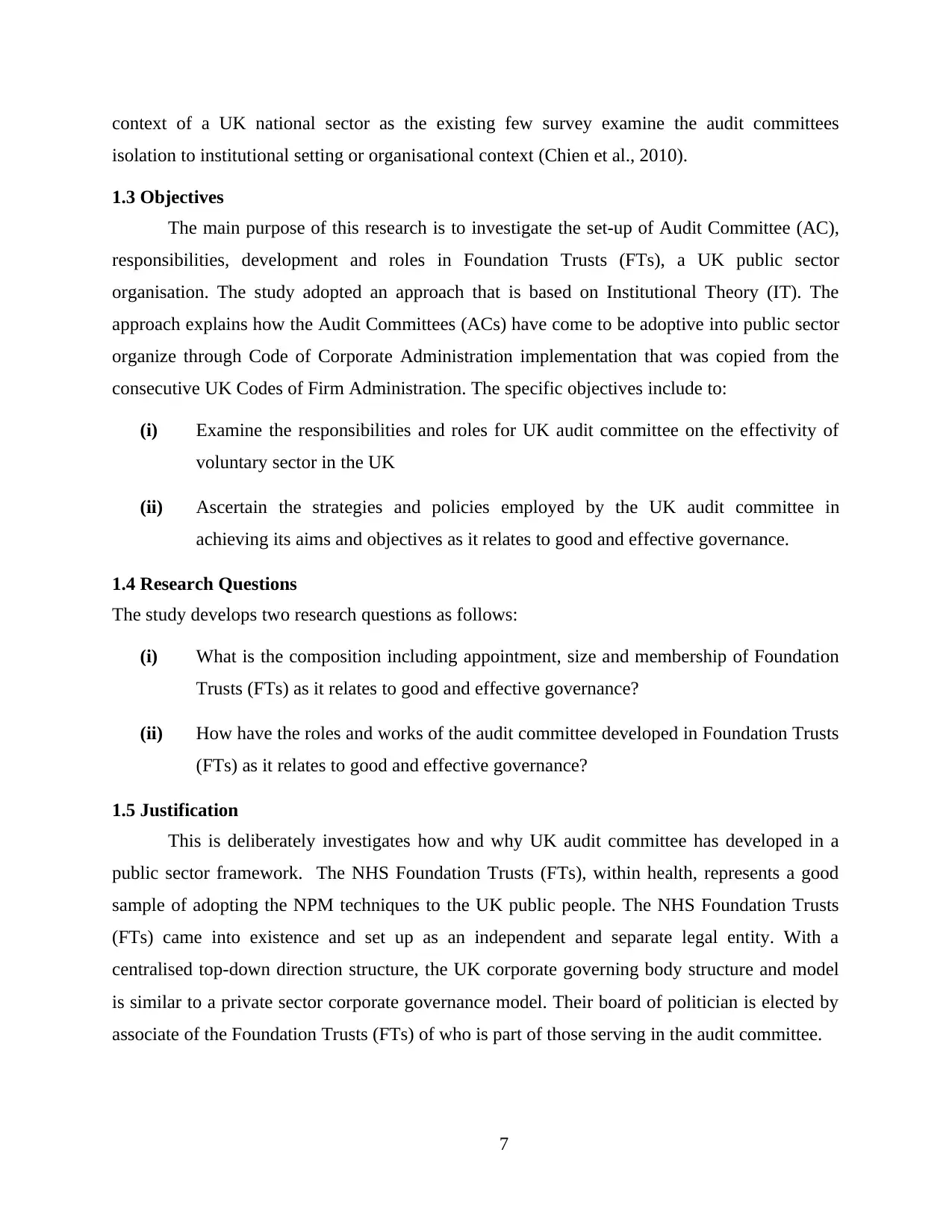
context of a UK national sector as the existing few survey examine the audit committees
isolation to institutional setting or organisational context (Chien et al., 2010).
1.3 Objectives
The main purpose of this research is to investigate the set-up of Audit Committee (AC),
responsibilities, development and roles in Foundation Trusts (FTs), a UK public sector
organisation. The study adopted an approach that is based on Institutional Theory (IT). The
approach explains how the Audit Committees (ACs) have come to be adoptive into public sector
organize through Code of Corporate Administration implementation that was copied from the
consecutive UK Codes of Firm Administration. The specific objectives include to:
(i) Examine the responsibilities and roles for UK audit committee on the effectivity of
voluntary sector in the UK
(ii) Ascertain the strategies and policies employed by the UK audit committee in
achieving its aims and objectives as it relates to good and effective governance.
1.4 Research Questions
The study develops two research questions as follows:
(i) What is the composition including appointment, size and membership of Foundation
Trusts (FTs) as it relates to good and effective governance?
(ii) How have the roles and works of the audit committee developed in Foundation Trusts
(FTs) as it relates to good and effective governance?
1.5 Justification
This is deliberately investigates how and why UK audit committee has developed in a
public sector framework. The NHS Foundation Trusts (FTs), within health, represents a good
sample of adopting the NPM techniques to the UK public people. The NHS Foundation Trusts
(FTs) came into existence and set up as an independent and separate legal entity. With a
centralised top-down direction structure, the UK corporate governing body structure and model
is similar to a private sector corporate governance model. Their board of politician is elected by
associate of the Foundation Trusts (FTs) of who is part of those serving in the audit committee.
7
isolation to institutional setting or organisational context (Chien et al., 2010).
1.3 Objectives
The main purpose of this research is to investigate the set-up of Audit Committee (AC),
responsibilities, development and roles in Foundation Trusts (FTs), a UK public sector
organisation. The study adopted an approach that is based on Institutional Theory (IT). The
approach explains how the Audit Committees (ACs) have come to be adoptive into public sector
organize through Code of Corporate Administration implementation that was copied from the
consecutive UK Codes of Firm Administration. The specific objectives include to:
(i) Examine the responsibilities and roles for UK audit committee on the effectivity of
voluntary sector in the UK
(ii) Ascertain the strategies and policies employed by the UK audit committee in
achieving its aims and objectives as it relates to good and effective governance.
1.4 Research Questions
The study develops two research questions as follows:
(i) What is the composition including appointment, size and membership of Foundation
Trusts (FTs) as it relates to good and effective governance?
(ii) How have the roles and works of the audit committee developed in Foundation Trusts
(FTs) as it relates to good and effective governance?
1.5 Justification
This is deliberately investigates how and why UK audit committee has developed in a
public sector framework. The NHS Foundation Trusts (FTs), within health, represents a good
sample of adopting the NPM techniques to the UK public people. The NHS Foundation Trusts
(FTs) came into existence and set up as an independent and separate legal entity. With a
centralised top-down direction structure, the UK corporate governing body structure and model
is similar to a private sector corporate governance model. Their board of politician is elected by
associate of the Foundation Trusts (FTs) of who is part of those serving in the audit committee.
7
Paraphrase This Document
Need a fresh take? Get an instant paraphrase of this document with our AI Paraphraser
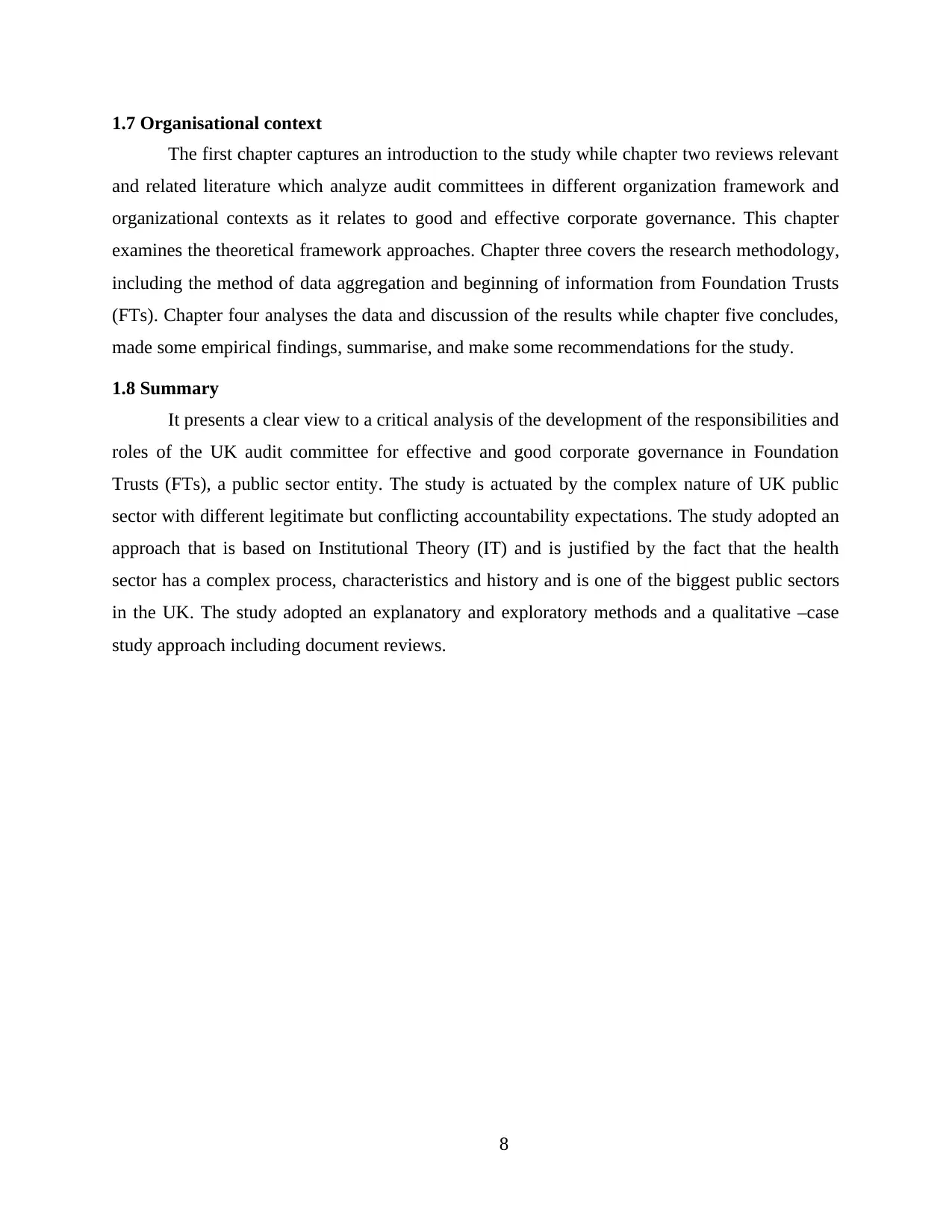
1.7 Organisational context
The first chapter captures an introduction to the study while chapter two reviews relevant
and related literature which analyze audit committees in different organization framework and
organizational contexts as it relates to good and effective corporate governance. This chapter
examines the theoretical framework approaches. Chapter three covers the research methodology,
including the method of data aggregation and beginning of information from Foundation Trusts
(FTs). Chapter four analyses the data and discussion of the results while chapter five concludes,
made some empirical findings, summarise, and make some recommendations for the study.
1.8 Summary
It presents a clear view to a critical analysis of the development of the responsibilities and
roles of the UK audit committee for effective and good corporate governance in Foundation
Trusts (FTs), a public sector entity. The study is actuated by the complex nature of UK public
sector with different legitimate but conflicting accountability expectations. The study adopted an
approach that is based on Institutional Theory (IT) and is justified by the fact that the health
sector has a complex process, characteristics and history and is one of the biggest public sectors
in the UK. The study adopted an explanatory and exploratory methods and a qualitative –case
study approach including document reviews.
8
The first chapter captures an introduction to the study while chapter two reviews relevant
and related literature which analyze audit committees in different organization framework and
organizational contexts as it relates to good and effective corporate governance. This chapter
examines the theoretical framework approaches. Chapter three covers the research methodology,
including the method of data aggregation and beginning of information from Foundation Trusts
(FTs). Chapter four analyses the data and discussion of the results while chapter five concludes,
made some empirical findings, summarise, and make some recommendations for the study.
1.8 Summary
It presents a clear view to a critical analysis of the development of the responsibilities and
roles of the UK audit committee for effective and good corporate governance in Foundation
Trusts (FTs), a public sector entity. The study is actuated by the complex nature of UK public
sector with different legitimate but conflicting accountability expectations. The study adopted an
approach that is based on Institutional Theory (IT) and is justified by the fact that the health
sector has a complex process, characteristics and history and is one of the biggest public sectors
in the UK. The study adopted an explanatory and exploratory methods and a qualitative –case
study approach including document reviews.
8
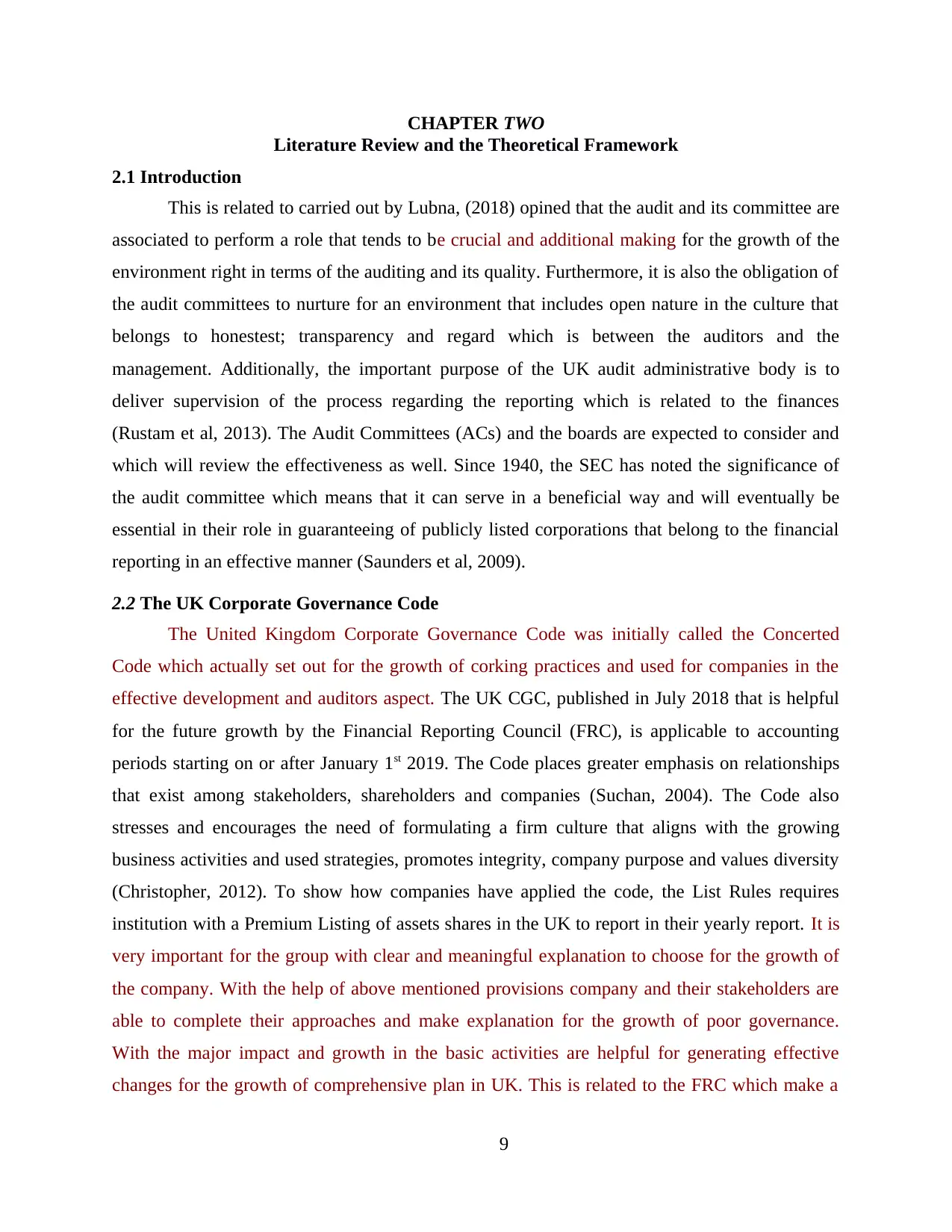
CHAPTER TWO
Literature Review and the Theoretical Framework
2.1 Introduction
This is related to carried out by Lubna, (2018) opined that the audit and its committee are
associated to perform a role that tends to be crucial and additional making for the growth of the
environment right in terms of the auditing and its quality. Furthermore, it is also the obligation of
the audit committees to nurture for an environment that includes open nature in the culture that
belongs to honestest; transparency and regard which is between the auditors and the
management. Additionally, the important purpose of the UK audit administrative body is to
deliver supervision of the process regarding the reporting which is related to the finances
(Rustam et al, 2013). The Audit Committees (ACs) and the boards are expected to consider and
which will review the effectiveness as well. Since 1940, the SEC has noted the significance of
the audit committee which means that it can serve in a beneficial way and will eventually be
essential in their role in guaranteeing of publicly listed corporations that belong to the financial
reporting in an effective manner (Saunders et al, 2009).
2.2 The UK Corporate Governance Code
The United Kingdom Corporate Governance Code was initially called the Concerted
Code which actually set out for the growth of corking practices and used for companies in the
effective development and auditors aspect. The UK CGC, published in July 2018 that is helpful
for the future growth by the Financial Reporting Council (FRC), is applicable to accounting
periods starting on or after January 1st 2019. The Code places greater emphasis on relationships
that exist among stakeholders, shareholders and companies (Suchan, 2004). The Code also
stresses and encourages the need of formulating a firm culture that aligns with the growing
business activities and used strategies, promotes integrity, company purpose and values diversity
(Christopher, 2012). To show how companies have applied the code, the List Rules requires
institution with a Premium Listing of assets shares in the UK to report in their yearly report. It is
very important for the group with clear and meaningful explanation to choose for the growth of
the company. With the help of above mentioned provisions company and their stakeholders are
able to complete their approaches and make explanation for the growth of poor governance.
With the major impact and growth in the basic activities are helpful for generating effective
changes for the growth of comprehensive plan in UK. This is related to the FRC which make a
9
Literature Review and the Theoretical Framework
2.1 Introduction
This is related to carried out by Lubna, (2018) opined that the audit and its committee are
associated to perform a role that tends to be crucial and additional making for the growth of the
environment right in terms of the auditing and its quality. Furthermore, it is also the obligation of
the audit committees to nurture for an environment that includes open nature in the culture that
belongs to honestest; transparency and regard which is between the auditors and the
management. Additionally, the important purpose of the UK audit administrative body is to
deliver supervision of the process regarding the reporting which is related to the finances
(Rustam et al, 2013). The Audit Committees (ACs) and the boards are expected to consider and
which will review the effectiveness as well. Since 1940, the SEC has noted the significance of
the audit committee which means that it can serve in a beneficial way and will eventually be
essential in their role in guaranteeing of publicly listed corporations that belong to the financial
reporting in an effective manner (Saunders et al, 2009).
2.2 The UK Corporate Governance Code
The United Kingdom Corporate Governance Code was initially called the Concerted
Code which actually set out for the growth of corking practices and used for companies in the
effective development and auditors aspect. The UK CGC, published in July 2018 that is helpful
for the future growth by the Financial Reporting Council (FRC), is applicable to accounting
periods starting on or after January 1st 2019. The Code places greater emphasis on relationships
that exist among stakeholders, shareholders and companies (Suchan, 2004). The Code also
stresses and encourages the need of formulating a firm culture that aligns with the growing
business activities and used strategies, promotes integrity, company purpose and values diversity
(Christopher, 2012). To show how companies have applied the code, the List Rules requires
institution with a Premium Listing of assets shares in the UK to report in their yearly report. It is
very important for the group with clear and meaningful explanation to choose for the growth of
the company. With the help of above mentioned provisions company and their stakeholders are
able to complete their approaches and make explanation for the growth of poor governance.
With the major impact and growth in the basic activities are helpful for generating effective
changes for the growth of comprehensive plan in UK. This is related to the FRC which make a
9
⊘ This is a preview!⊘
Do you want full access?
Subscribe today to unlock all pages.

Trusted by 1+ million students worldwide
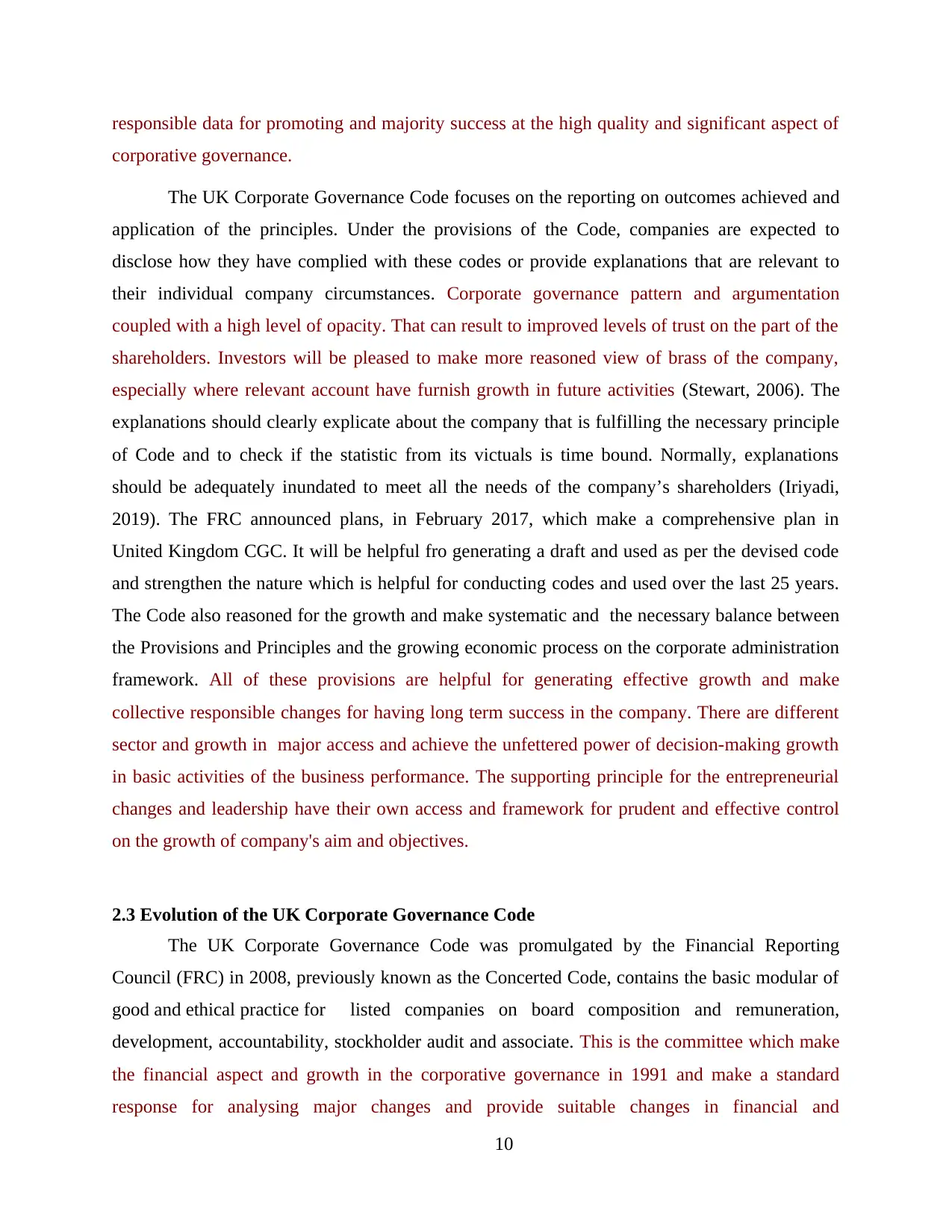
responsible data for promoting and majority success at the high quality and significant aspect of
corporative governance.
The UK Corporate Governance Code focuses on the reporting on outcomes achieved and
application of the principles. Under the provisions of the Code, companies are expected to
disclose how they have complied with these codes or provide explanations that are relevant to
their individual company circumstances. Corporate governance pattern and argumentation
coupled with a high level of opacity. That can result to improved levels of trust on the part of the
shareholders. Investors will be pleased to make more reasoned view of brass of the company,
especially where relevant account have furnish growth in future activities (Stewart, 2006). The
explanations should clearly explicate about the company that is fulfilling the necessary principle
of Code and to check if the statistic from its victuals is time bound. Normally, explanations
should be adequately inundated to meet all the needs of the company’s shareholders (Iriyadi,
2019). The FRC announced plans, in February 2017, which make a comprehensive plan in
United Kingdom CGC. It will be helpful fro generating a draft and used as per the devised code
and strengthen the nature which is helpful for conducting codes and used over the last 25 years.
The Code also reasoned for the growth and make systematic and the necessary balance between
the Provisions and Principles and the growing economic process on the corporate administration
framework. All of these provisions are helpful for generating effective growth and make
collective responsible changes for having long term success in the company. There are different
sector and growth in major access and achieve the unfettered power of decision-making growth
in basic activities of the business performance. The supporting principle for the entrepreneurial
changes and leadership have their own access and framework for prudent and effective control
on the growth of company's aim and objectives.
2.3 Evolution of the UK Corporate Governance Code
The UK Corporate Governance Code was promulgated by the Financial Reporting
Council (FRC) in 2008, previously known as the Concerted Code, contains the basic modular of
good and ethical practice for listed companies on board composition and remuneration,
development, accountability, stockholder audit and associate. This is the committee which make
the financial aspect and growth in the corporative governance in 1991 and make a standard
response for analysing major changes and provide suitable changes in financial and
10
corporative governance.
The UK Corporate Governance Code focuses on the reporting on outcomes achieved and
application of the principles. Under the provisions of the Code, companies are expected to
disclose how they have complied with these codes or provide explanations that are relevant to
their individual company circumstances. Corporate governance pattern and argumentation
coupled with a high level of opacity. That can result to improved levels of trust on the part of the
shareholders. Investors will be pleased to make more reasoned view of brass of the company,
especially where relevant account have furnish growth in future activities (Stewart, 2006). The
explanations should clearly explicate about the company that is fulfilling the necessary principle
of Code and to check if the statistic from its victuals is time bound. Normally, explanations
should be adequately inundated to meet all the needs of the company’s shareholders (Iriyadi,
2019). The FRC announced plans, in February 2017, which make a comprehensive plan in
United Kingdom CGC. It will be helpful fro generating a draft and used as per the devised code
and strengthen the nature which is helpful for conducting codes and used over the last 25 years.
The Code also reasoned for the growth and make systematic and the necessary balance between
the Provisions and Principles and the growing economic process on the corporate administration
framework. All of these provisions are helpful for generating effective growth and make
collective responsible changes for having long term success in the company. There are different
sector and growth in major access and achieve the unfettered power of decision-making growth
in basic activities of the business performance. The supporting principle for the entrepreneurial
changes and leadership have their own access and framework for prudent and effective control
on the growth of company's aim and objectives.
2.3 Evolution of the UK Corporate Governance Code
The UK Corporate Governance Code was promulgated by the Financial Reporting
Council (FRC) in 2008, previously known as the Concerted Code, contains the basic modular of
good and ethical practice for listed companies on board composition and remuneration,
development, accountability, stockholder audit and associate. This is the committee which make
the financial aspect and growth in the corporative governance in 1991 and make a standard
response for analysing major changes and provide suitable changes in financial and
10
Paraphrase This Document
Need a fresh take? Get an instant paraphrase of this document with our AI Paraphraser
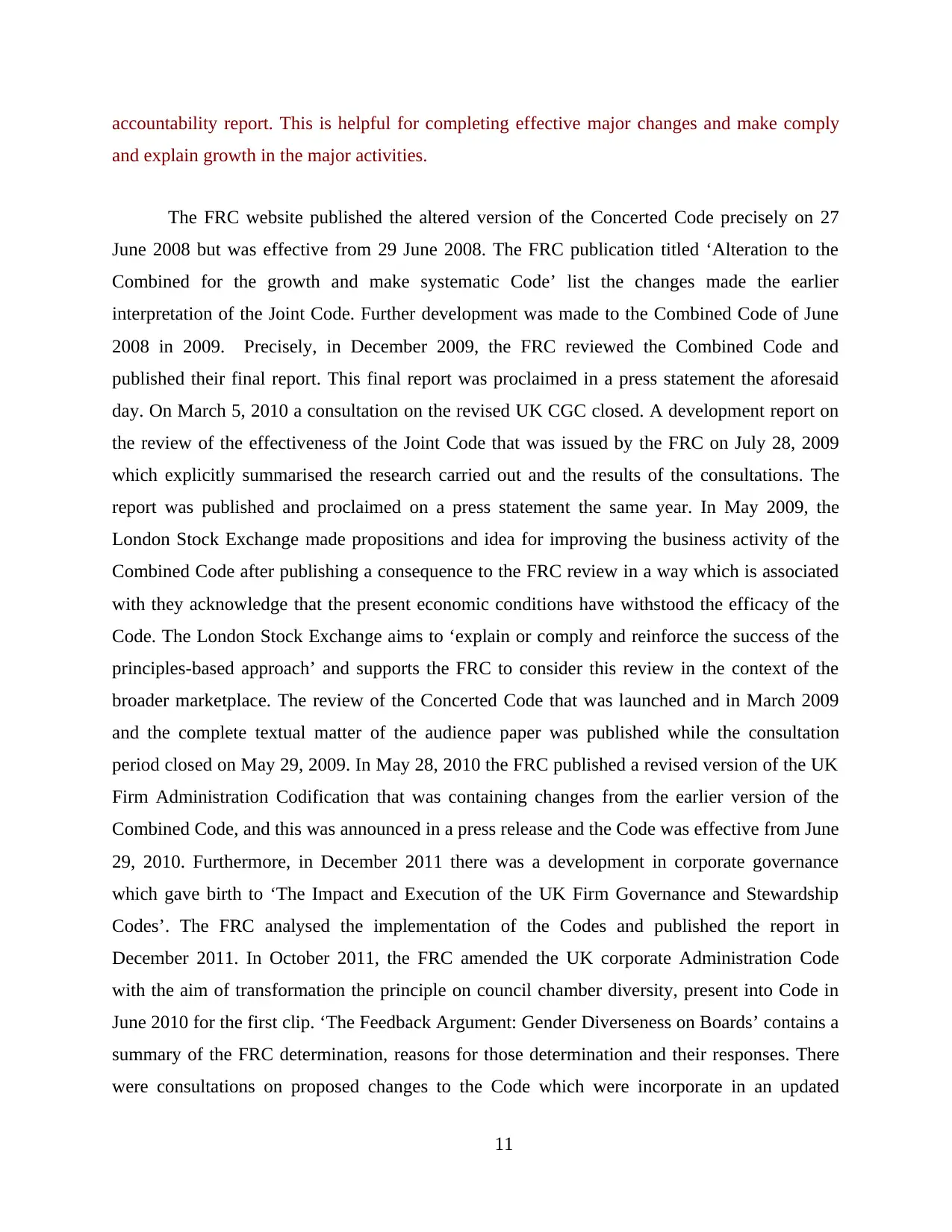
accountability report. This is helpful for completing effective major changes and make comply
and explain growth in the major activities.
The FRC website published the altered version of the Concerted Code precisely on 27
June 2008 but was effective from 29 June 2008. The FRC publication titled ‘Alteration to the
Combined for the growth and make systematic Code’ list the changes made the earlier
interpretation of the Joint Code. Further development was made to the Combined Code of June
2008 in 2009. Precisely, in December 2009, the FRC reviewed the Combined Code and
published their final report. This final report was proclaimed in a press statement the aforesaid
day. On March 5, 2010 a consultation on the revised UK CGC closed. A development report on
the review of the effectiveness of the Joint Code that was issued by the FRC on July 28, 2009
which explicitly summarised the research carried out and the results of the consultations. The
report was published and proclaimed on a press statement the same year. In May 2009, the
London Stock Exchange made propositions and idea for improving the business activity of the
Combined Code after publishing a consequence to the FRC review in a way which is associated
with they acknowledge that the present economic conditions have withstood the efficacy of the
Code. The London Stock Exchange aims to ‘explain or comply and reinforce the success of the
principles-based approach’ and supports the FRC to consider this review in the context of the
broader marketplace. The review of the Concerted Code that was launched and in March 2009
and the complete textual matter of the audience paper was published while the consultation
period closed on May 29, 2009. In May 28, 2010 the FRC published a revised version of the UK
Firm Administration Codification that was containing changes from the earlier version of the
Combined Code, and this was announced in a press release and the Code was effective from June
29, 2010. Furthermore, in December 2011 there was a development in corporate governance
which gave birth to ‘The Impact and Execution of the UK Firm Governance and Stewardship
Codes’. The FRC analysed the implementation of the Codes and published the report in
December 2011. In October 2011, the FRC amended the UK corporate Administration Code
with the aim of transformation the principle on council chamber diversity, present into Code in
June 2010 for the first clip. ‘The Feedback Argument: Gender Diverseness on Boards’ contains a
summary of the FRC determination, reasons for those determination and their responses. There
were consultations on proposed changes to the Code which were incorporate in an updated
11
and explain growth in the major activities.
The FRC website published the altered version of the Concerted Code precisely on 27
June 2008 but was effective from 29 June 2008. The FRC publication titled ‘Alteration to the
Combined for the growth and make systematic Code’ list the changes made the earlier
interpretation of the Joint Code. Further development was made to the Combined Code of June
2008 in 2009. Precisely, in December 2009, the FRC reviewed the Combined Code and
published their final report. This final report was proclaimed in a press statement the aforesaid
day. On March 5, 2010 a consultation on the revised UK CGC closed. A development report on
the review of the effectiveness of the Joint Code that was issued by the FRC on July 28, 2009
which explicitly summarised the research carried out and the results of the consultations. The
report was published and proclaimed on a press statement the same year. In May 2009, the
London Stock Exchange made propositions and idea for improving the business activity of the
Combined Code after publishing a consequence to the FRC review in a way which is associated
with they acknowledge that the present economic conditions have withstood the efficacy of the
Code. The London Stock Exchange aims to ‘explain or comply and reinforce the success of the
principles-based approach’ and supports the FRC to consider this review in the context of the
broader marketplace. The review of the Concerted Code that was launched and in March 2009
and the complete textual matter of the audience paper was published while the consultation
period closed on May 29, 2009. In May 28, 2010 the FRC published a revised version of the UK
Firm Administration Codification that was containing changes from the earlier version of the
Combined Code, and this was announced in a press release and the Code was effective from June
29, 2010. Furthermore, in December 2011 there was a development in corporate governance
which gave birth to ‘The Impact and Execution of the UK Firm Governance and Stewardship
Codes’. The FRC analysed the implementation of the Codes and published the report in
December 2011. In October 2011, the FRC amended the UK corporate Administration Code
with the aim of transformation the principle on council chamber diversity, present into Code in
June 2010 for the first clip. ‘The Feedback Argument: Gender Diverseness on Boards’ contains a
summary of the FRC determination, reasons for those determination and their responses. There
were consultations on proposed changes to the Code which were incorporate in an updated
11
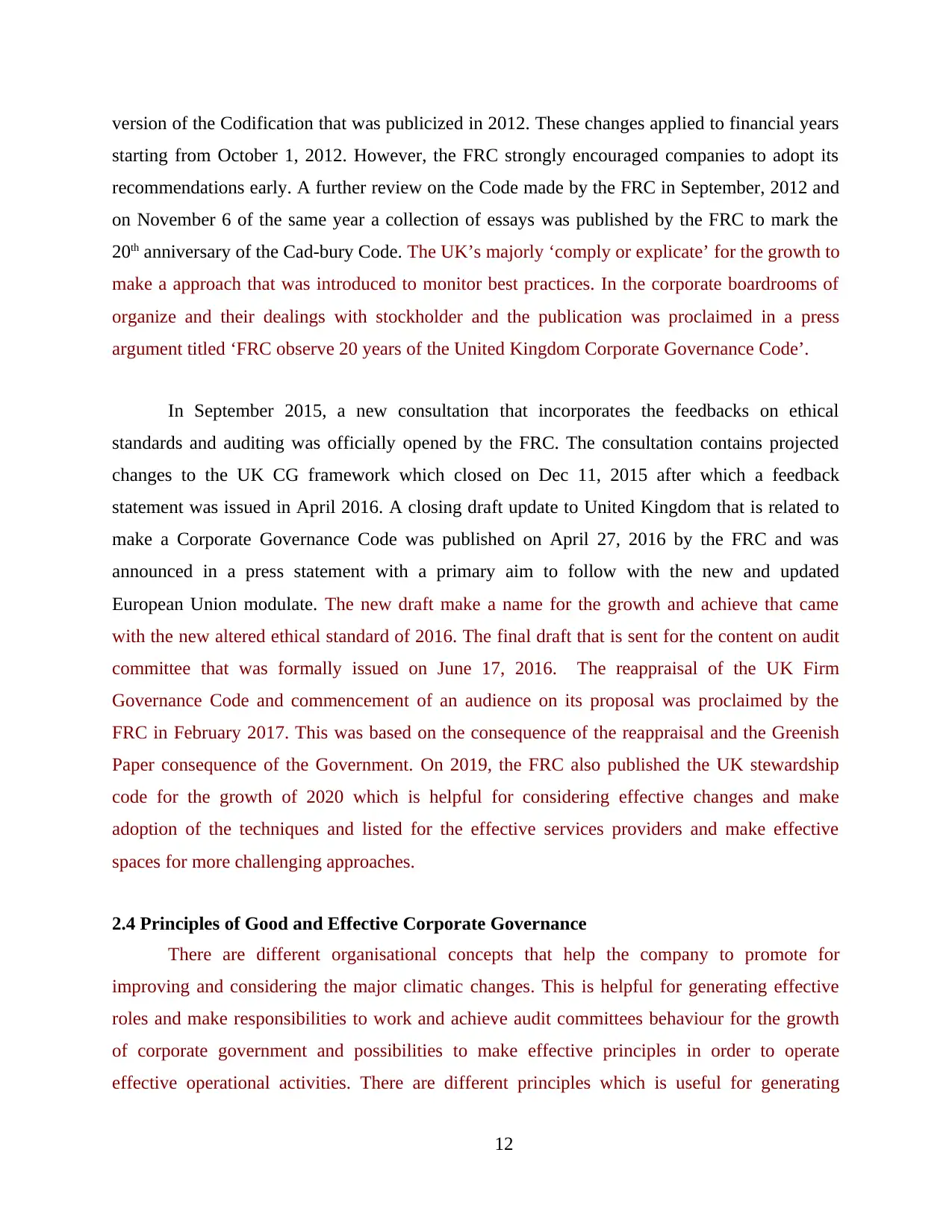
version of the Codification that was publicized in 2012. These changes applied to financial years
starting from October 1, 2012. However, the FRC strongly encouraged companies to adopt its
recommendations early. A further review on the Code made by the FRC in September, 2012 and
on November 6 of the same year a collection of essays was published by the FRC to mark the
20th anniversary of the Cad-bury Code. The UK’s majorly ‘comply or explicate’ for the growth to
make a approach that was introduced to monitor best practices. In the corporate boardrooms of
organize and their dealings with stockholder and the publication was proclaimed in a press
argument titled ‘FRC observe 20 years of the United Kingdom Corporate Governance Code’.
In September 2015, a new consultation that incorporates the feedbacks on ethical
standards and auditing was officially opened by the FRC. The consultation contains projected
changes to the UK CG framework which closed on Dec 11, 2015 after which a feedback
statement was issued in April 2016. A closing draft update to United Kingdom that is related to
make a Corporate Governance Code was published on April 27, 2016 by the FRC and was
announced in a press statement with a primary aim to follow with the new and updated
European Union modulate. The new draft make a name for the growth and achieve that came
with the new altered ethical standard of 2016. The final draft that is sent for the content on audit
committee that was formally issued on June 17, 2016. The reappraisal of the UK Firm
Governance Code and commencement of an audience on its proposal was proclaimed by the
FRC in February 2017. This was based on the consequence of the reappraisal and the Greenish
Paper consequence of the Government. On 2019, the FRC also published the UK stewardship
code for the growth of 2020 which is helpful for considering effective changes and make
adoption of the techniques and listed for the effective services providers and make effective
spaces for more challenging approaches.
2.4 Principles of Good and Effective Corporate Governance
There are different organisational concepts that help the company to promote for
improving and considering the major climatic changes. This is helpful for generating effective
roles and make responsibilities to work and achieve audit committees behaviour for the growth
of corporate government and possibilities to make effective principles in order to operate
effective operational activities. There are different principles which is useful for generating
12
starting from October 1, 2012. However, the FRC strongly encouraged companies to adopt its
recommendations early. A further review on the Code made by the FRC in September, 2012 and
on November 6 of the same year a collection of essays was published by the FRC to mark the
20th anniversary of the Cad-bury Code. The UK’s majorly ‘comply or explicate’ for the growth to
make a approach that was introduced to monitor best practices. In the corporate boardrooms of
organize and their dealings with stockholder and the publication was proclaimed in a press
argument titled ‘FRC observe 20 years of the United Kingdom Corporate Governance Code’.
In September 2015, a new consultation that incorporates the feedbacks on ethical
standards and auditing was officially opened by the FRC. The consultation contains projected
changes to the UK CG framework which closed on Dec 11, 2015 after which a feedback
statement was issued in April 2016. A closing draft update to United Kingdom that is related to
make a Corporate Governance Code was published on April 27, 2016 by the FRC and was
announced in a press statement with a primary aim to follow with the new and updated
European Union modulate. The new draft make a name for the growth and achieve that came
with the new altered ethical standard of 2016. The final draft that is sent for the content on audit
committee that was formally issued on June 17, 2016. The reappraisal of the UK Firm
Governance Code and commencement of an audience on its proposal was proclaimed by the
FRC in February 2017. This was based on the consequence of the reappraisal and the Greenish
Paper consequence of the Government. On 2019, the FRC also published the UK stewardship
code for the growth of 2020 which is helpful for considering effective changes and make
adoption of the techniques and listed for the effective services providers and make effective
spaces for more challenging approaches.
2.4 Principles of Good and Effective Corporate Governance
There are different organisational concepts that help the company to promote for
improving and considering the major climatic changes. This is helpful for generating effective
roles and make responsibilities to work and achieve audit committees behaviour for the growth
of corporate government and possibilities to make effective principles in order to operate
effective operational activities. There are different principles which is useful for generating
12
⊘ This is a preview!⊘
Do you want full access?
Subscribe today to unlock all pages.

Trusted by 1+ million students worldwide
1 out of 37
Related Documents
Your All-in-One AI-Powered Toolkit for Academic Success.
+13062052269
info@desklib.com
Available 24*7 on WhatsApp / Email
![[object Object]](/_next/static/media/star-bottom.7253800d.svg)
Unlock your academic potential
Copyright © 2020–2025 A2Z Services. All Rights Reserved. Developed and managed by ZUCOL.




